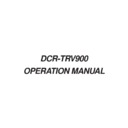Sony DCR-TRV900 Service Manual ▷ View online
8
1-4. Power Reset Description
The HI controller is backed up by the lithium battery. Various data (clock data and
others) are backed up by the backup battery. When the main power of the DCR-
TRV900 is turned off, the HI controller is reset by the reset IC. Then the HI
controller resets the mechanism controller and the camera controller. The mecha-
nism controller that is in charge of the system reset, performs the following resets.
1 VTR reset
2 LIP reset
3 ADA reset
4 EEP reset
2 LIP reset
3 ADA reset
4 EEP reset
The camera controller resets the entire camera system.
When these resets are completed, the mechanism deck and the camera block are
initialized. Then the DCR-TRV900 enters the standby state.
Power supplies in use
The following three power supply systems are used.
(1) 2 V system (Operating range 1.8 V to 2.2 V)
→
Used at 1.9 V
(2) 3 V system (Operating range 2.7 V to 3.3 V)
→
Used at 2.8 V
(3) 5 V system (Operating range 4.5 V to 5.5 V)
→
Used at 4.6 V
POWER ON
System reset
Reset IC
HI controller
E
E
P
E
P
R
E
S
E
E
S
E
T
A
D
A
D
A
R
E
S
E
E
S
E
T
L
I
P
R
E
S
E
E
S
E
T
V
T
R
R
E
S
E
E
S
E
T
Camera reset
Camera controller
Mechanism controller
9
4.6
2.8
2.8
4.6
2.8
2.8
4.6
2.8
2.8
4.6
2.8
2.8
4.6
2.8
2.8
2.8
1.9
1.9
2.8
1.9
1.9
2.8
1.9
1.9
2.8
1.9
1.9
2.8
2.8
1.9
1.9
4.6
4.6
2.8
2.8
2.8
4.6
2.8
2.8
2.8
1.9
2.8
2.8
2.8
4.6
2.8
4.6
2.8
4.6
2.8
12, -6.5
12, -6.5
2.8
2.8
12
-6.5
2.8
Birds
EEPR
OM
Lens Driver
IRIS
TG
GCAM
CCD
2.8
2.8
2.8
2.8
4.6
4.6
2.8
2.8
4.6
2.8
2.8
4.6
2.8
2.8
4.6
2.8
2.8
OSD
LCD DAC
EVF DAC
IR
BBI
EVF
LCD
SIRCS
CHIME
2.8
2.8
CAM DDON
LANC
VTRDDON
EVFDDON
LCDDDON
Chime Power Cont
System reset
BACK UP
EVER
LANC DC OUT
5.2V
5.2V
UNREG
Camera
reset
reset
Independent reset
is used
is used
VTR reset
LIP reset
ADA reset
EEP reset
Reset
IC
Battery
LCD driver
CAP DRV
DRM DRV
DRM PREDRV
TRF
TRW
TRX
TFD
SFD
VFD
DAC
LIP
MIC AMP
ABC
ADA
AOI
EEPROM
EEPROM
IC759
HONEY
JPFG
DRAM(16M)
DRAM(4M)
PC card I/F
20MHz CLK
Lithium battery
HI controller
Mechanism controller
Switching
power supply
for VTR block
power supply
for VTR block
DD converter
Switching
power supply
for camera block
power supply
for camera block
Camera controller
DS converter
Angular
velocity sensor
velocity sensor
Power Reset Description Diagram
10
2. CAMERA CIRCUIT
2-1. Record Mode
Dichroic Prism
The incident light that is introduced from the lens block, is adjusted of its amount
by iris and enters the dichroic prism.
The incident light is separated into the three primary spectrum of R, G and B.
CCD Imager (IC100, IC101, IC102)
The CCD imager is driven by the pulses (V1 to V3, H1, H2 and PG) that are
supplied from the timing generator.
The incident light to the CCD imager is converted to the electrical signals of R,
G and B.
Sample-and-hold, AGC (IC203)
The output signal from the CCD imager is sample-and-held by the signals
(XSHIP, XSHD) that are supplied from the timing generator. The sample-and-
hold is performed in order to ensure operation of the A/D conversion at the latter
circuit. When the signal amplitude after sample-and-hold is small, the signal is
amplified by the AGC amplifier to obtain the sufficient amplitude.
The right end and the left end of B signal output that is introduced to this IC
from the CCD imager, is horizontally inverted due physical structure of the
dichroic prism.
A/D Converter (IC206, IC205, IC207)
The R. G. B. video signal that are output from the sample-and-hold (IC203) are
converted from analog signal to 10-bit digital signal in accordance with the
sampling frequency which is generated by the timing generator.
Digital Camera Processor (IC300)
The B channel signal is stored in a line-memory in this processor where the
right end and the left end of B signal are inverted to the correct sequence. Then
the R. G. B. signals receive the white balance adjustment, gamma correction
and are mixed to the Y signal and the color difference signal.
Timing Generator (IC204)
The master frequency of 27 MHz is frequency divided-by-2 and is used as the
timing pulse of the camera system.
AE (Auto Exposure)
Amplitude of the video signal that is input to the digital camera processor (IC300)
is detected. The output signal of the amplitude detection is sent to the camera
controller (IC302) that controls the iris drive amplifier (IC501) so that the lens
iris is controlled in accordance with the signal amplitude.
ND Filter
The same detection circuit as the AE operation, is used for the ND control.
When an ND filter needs to be inserted in the optical path, the message “ND
ON” is displayed on the LED and LCD screens.
11
Camera Block Diagram
Click on the first or last page to see other DCR-TRV900 service manuals if exist.

